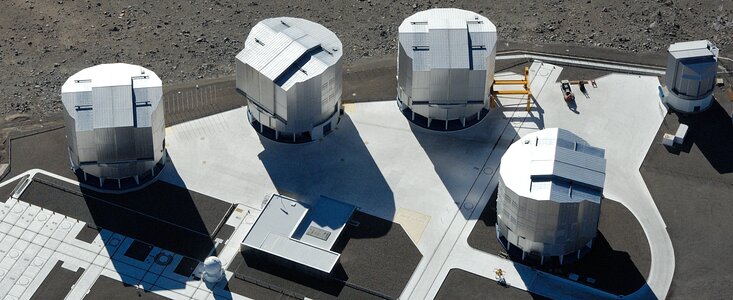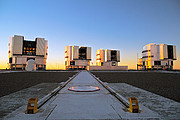Annuncio
Due decenni di scoperte con il Very Large Telescope Interferometer dell'ESO: buon compleanno VLTI!
29 Ottobre 2021
Vent'anni fa, oggi, la luce di due degli UT (Unit Telescopes) da 8,2 metri del VLT (Very Large Telescope) dell'ESO all'Osservatorio del Paranal in Cile è stata combinata per la prima volta. L'evento ha segnato il momento storico in cui questi telescopi hanno operato per la prima volta come un vero interferometro, dando inizio a una nuova era per l’astronomia.
Quando i fasci di luce dei due UT sono stati combinati la notte del 29 ottobre 2001, il VLTI non solo ha iniziato con successo le sue operazioni, ma ha anche fornito i suoi primi risultati scientifici: la misura delle dimensioni della stella meridionale Achernar, che è risultata essere circa dieci volte più grande del Sole. Nelle successive tre notti di osservazioni scientifiche, il VLTI ha mostrato il suo eccellente potenziale misurando altre dieci stelle, in particolare realizzando la prima osservazione interferometrica del bizzarro sistema stellare Eta Carinae.
Il concetto del VLTI era stato dimostrato con successo alcuni mesi prima, il 17 marzo 2001. Quella notte la luce di un'altra stella, la luminosa Sirio, fu raccolta e combinata con due piccoli telescopi (chiamati siderostati) costruiti appositamente per le prime fasi di test del VLTI.
La combinazione della luce dei siderostati e, successivamente, degli UT era solo l'inizio del cammino dell'interferometro. Il VLTI può funzionare anche utilizzando quattro AT (Auxiliary Telescopes) mobili da 1,8 metri di diametro, che sono stati completati tra il 2004 e il 2006. Nel febbraio 2005, la luce di due AT è stata combinata per la prima volta, segnando un'altra importante pietra miliare nella vita dell'interferometro. Gli AT combinano la loro luce in modo simile agli UT, con la differenza che gli AT possono essere spostati fino a 30 posizioni diverse lungo la piattaforma del Paranal. Questo offre una serie di diverse configurazioni interferometriche, permettendo al VLTI di raggiungere il suo pieno potenziale osservativo.
L'integrazione della luce raccolta dagli UT o dagli AT permette al VLTI di agire come un unico strumento "virtuale" con un diametro grande quanto la distanza tra i singoli telescopi (chiamata "linea di base"). L'interferometro è attualmente in funzione con linee di base che raggiungono i 140 metri, a seconda della posizione degli AT. Quando la luce di due UT è stata combinata per la prima volta nell'ottobre 2001, la linea di base era di circa 102 metri, consentendo al VLTI di vedere dettagli sulla superficie di Achernar con una risoluzione equivalente a quella di un camion lungo 4 metri sulla superficie della Luna. La risoluzione del VLTI, insieme alla capacità dei singoli telescopi di raccogliere la luce, fanno del VLTI uno dei più potenti interferometri ottici sulla Terra.
Grazie a questo eccezionale livello di dettaglio, il VLTI dell'ESO ha contribuito a gettare nuova luce su molti campi di ricerca in astronomia nei suoi due decenni di attività. La ricerca effettuata sui dati VLTI ha contribuito a più di 450 pubblicazioni scientifiche dal 2002. Queste includono risultati sensazionali, come le osservazioni del 2020, premiate con il Nobel, delle stelle che orbitano intorno al buco nero supermassiccio al centro della Via Lattea, la prima osservazione diretta di un esopianeta usando l'interferometria ottica, l'immagine a più alta risoluzione del sistema stellare Eta Carinae, la rilevazione della luce eso-zodiacale, la migliore immagine in assoluto della superficie e dell'atmosfera di una stella e la visione più nitida di sempre di un disco di polvere intorno a una stella senescente.
Il VLTI dell'ESO non avrebbe potuto raggiungere tutti questi straordinari risultati senza la sua serie di strumenti di classe mondiale, compresi quelli attualmente in funzione - PIONIER, GRAVITY e MATISSE - che hanno visto la prima luce tra il 2010 e il 2018.
Links
- VLTI (Very Large Telescope Interferometer)
- L'articolo di The Messenger sulle "first fringes" con due telescopi VLT (dicembre 2001)
- Comunicato stampa ESO: Occhi giganti per l'interferometro del VLT (novembre 2001)
Contatti
Antoine Mérand
VLTI Programme Scientist
European Southern Observatory
Garching bei München, Germany
Tel: +49 89 3200 6630
Email: amerand@eso.org
Bárbara Ferreira
ESO Media Manager
Garching bei München, Germany
Tel: +49 89 3200 6670
Email: press@eso.org
Riguardo all'annuncio
| Identificazione: | ann21015 |
Our use of Cookies
We use cookies that are essential for accessing our websites and using our services. We also use cookies to analyse, measure and improve our websites’ performance, to enable content sharing via social media and to display media content hosted on third-party platforms.
ESO Cookies Policy
The European Organisation for Astronomical Research in the Southern Hemisphere (ESO) is the pre-eminent intergovernmental science and technology organisation in astronomy. It carries out an ambitious programme focused on the design, construction and operation of powerful ground-based observing facilities for astronomy.
This Cookies Policy is intended to provide clarity by outlining the cookies used on the ESO public websites, their functions, the options you have for controlling them, and the ways you can contact us for additional details.
What are cookies?
Cookies are small pieces of data stored on your device by websites you visit. They serve various purposes, such as remembering login credentials and preferences and enhance your browsing experience.
Categories of cookies we use
Essential cookies (always active): These cookies are strictly necessary for the proper functioning of our website. Without these cookies, the website cannot operate correctly, and certain services, such as logging in or accessing secure areas, may not be available; because they are essential for the website’s operation, they cannot be disabled.
Functional Cookies: These cookies enhance your browsing experience by enabling additional features and personalization, such as remembering your preferences and settings. While not strictly necessary for the website to function, they improve usability and convenience; these cookies are only placed if you provide your consent.
Analytics cookies: These cookies collect information about how visitors interact with our website, such as which pages are visited most often and how users navigate the site. This data helps us improve website performance, optimize content, and enhance the user experience; these cookies are only placed if you provide your consent. We use the following analytics cookies.
Matomo Cookies:
This website uses Matomo (formerly Piwik), an open source software which enables the statistical analysis of website visits. Matomo uses cookies (text files) which are saved on your computer and which allow us to analyze how you use our website. The website user information generated by the cookies will only be saved on the servers of our IT Department. We use this information to analyze www.eso.org visits and to prepare reports on website activities. These data will not be disclosed to third parties.
On behalf of ESO, Matomo will use this information for the purpose of evaluating your use of the website, compiling reports on website activity and providing other services relating to website activity and internet usage.
Matomo cookies settings:
Additional Third-party cookies on ESO websites: some of our pages display content from external providers, e.g. YouTube.
Such third-party services are outside of ESO control and may, at any time, change their terms of service, use of cookies, etc.
YouTube: Some videos on the ESO website are embedded from ESO’s official YouTube channel. We have enabled YouTube’s privacy-enhanced mode, meaning that no cookies are set unless the user actively clicks on the video to play it. Additionally, in this mode, YouTube does not store any personally identifiable cookie data for embedded video playbacks. For more details, please refer to YouTube’s embedding videos information page.
Cookies can also be classified based on the following elements.
Regarding the domain, there are:
- First-party cookies, set by the website you are currently visiting. They are stored by the same domain that you are browsing and are used to enhance your experience on that site;
- Third-party cookies, set by a domain other than the one you are currently visiting.
As for their duration, cookies can be:
- Browser-session cookies, which are deleted when the user closes the browser;
- Stored cookies, which stay on the user's device for a predetermined period of time.
How to manage cookies
Cookie settings: You can modify your cookie choices for the ESO webpages at any time by clicking on the link Cookie settings at the bottom of any page.
In your browser: If you wish to delete cookies or instruct your browser to delete or block cookies by default, please visit the help pages of your browser:
Please be aware that if you delete or decline cookies, certain functionalities of our website may be not be available and your browsing experience may be affected.
You can set most browsers to prevent any cookies being placed on your device, but you may then have to manually adjust some preferences every time you visit a site/page. And some services and functionalities may not work properly at all (e.g. profile logging-in, shop check out).
Updates to the ESO Cookies Policy
The ESO Cookies Policy may be subject to future updates, which will be made available on this page.
Additional information
For any queries related to cookies, please contact: pdprATesoDOTorg.
As ESO public webpages are managed by our Department of Communication, your questions will be dealt with the support of the said Department.




